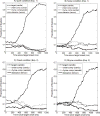The Temporal Dynamics of Spoken Word Recognition in Adverse Listening Conditions
- PMID: 26420754
- PMCID: PMC5664918
- DOI: 10.1007/s10936-015-9396-9
The Temporal Dynamics of Spoken Word Recognition in Adverse Listening Conditions
Abstract
This study examined the temporal dynamics of spoken word recognition in noise and background speech. In two visual-world experiments, English participants listened to target words while looking at four pictures on the screen: a target (e.g. candle), an onset competitor (e.g. candy), a rhyme competitor (e.g. sandal), and an unrelated distractor (e.g. lemon). Target words were presented in quiet, mixed with broadband noise, or mixed with background speech. Results showed that lexical competition changes throughout the observation window as a function of what is presented in the background. These findings suggest that, rather than being strictly sequential, stream segregation and lexical competition interact during spoken word recognition.
Keywords: Eye-tracking; Lexical competition; Spoken word recognition; Stream segregation.
Figures
References
-
- Allopenna PD, Magnuson JS, Tanenhaus MK. Tracking the time course of spoken word recognition using eye movements: evidence for continuous mapping models. Journal of Memory and Language. 1998;38:419–439.
-
- Baayen RH, Davidson DJ, Bates DM. Mixed-effects modeling with crossed random effects for subjects and items. Journal of Memory and Language. 2008;59:390–412.
-
- Barr DJ. Analyzing ‘visual world’ eye tracking data using multilevel logistic regression. Journal of Memory and Language. 2008;59:457–474.
-
- Ben-David BM, Chambers CG, Daneman M, Pichora-Fuller KM, Reingold EM, Schneider B. Effects of aging and noise on real-time spoken word recognition: Evidence from eye movements. Journal of Speech, Language and Hearing Research. 2010;54:243–262. - PubMed
-
- Brouwer S, Mitterer H, Huettig F. Speech reductions change the dynamics of competition during spoken word recognition. Language and Cognitive Processes. 2012;27(4):539–571.
MeSH terms
Grants and funding
LinkOut - more resources
Full Text Sources
Other Literature Sources


